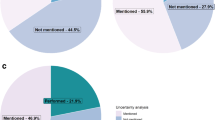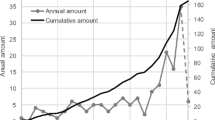Abstract
Purpose
In LCA, a multi-functionality problem exists whenever the environmental impacts of a multi-functional process have to be allocated between its multiple functions. Methods for fixing this multi-functionality problem are controversially discussed because the methods include ambiguous choices. To study the influence of these choices, the ISO standard requires a sensitivity analysis. This work presents an analytical method for analyzing sensitivities and uncertainties of LCA results with respect to the choices made when a multi-functionality problem is fixed.
Methods
The existing matrix algebra for LCA is expanded by explicit equations for methods that fix multi-functionality problems: allocation and avoided burden. For allocation, choices exist between alternative allocation factors. The expanded equations allow calculating LCA results as a function of allocation factors. For avoided burden, choices exist in selecting an avoided burden process from multiple candidates. This choice is represented by so-called aggregation factors. For avoided burden, the expanded equations calculate LCA results as a function of aggregation factors. The expanded equations are used to derive sensitivity coefficients for LCA results with respect to allocation factors and aggregation factors. Based on the sensitivity coefficients, uncertainties due to fixing a multi-functionality problem by allocation or avoided burden are analytically propagated. The method is illustrated using a virtual numerical example.
Results and discussion
The presented approach rigorously quantifies sensitivities of LCA results with respect to the choices made when multi-functionality problems are fixed with allocation and avoided burden. The uncertainties due to fixing multi-functionality problems are analytically propagated to uncertainties in LCA results using a first-order approximation. For uncertainties in allocation factors, the first-order approximation is exact if no loops of the allocated functional flows exist. The contribution of uncertainties due to fixing multi-functionality problems can be directly compared to the uncertainty contributions induced by uncertain process data or characterization factors. The presented method allows the computationally efficient study of uncertainties due to fixing multi-functionality problems and could be automated in software tools.
Conclusions
This work provides a systematic method for the sensitivity analysis required by the ISO standard in case choices between alternative allocation procedures exist. The resulting analytical approach includes contributions of uncertainties in process data, characterization factors, and—in extension to existing methods—uncertainties due to fixing multi-functionality problems in a unifying rigorous framework. Based on the uncertainty contributions, LCA practitioners can select fields for data refinement to decrease the overall uncertainty in LCA results.




Similar content being viewed by others
References
Ardente F, Cellura M (2012) Economic allocation in life cycle assessment. J Ind Ecol 16(3):387–398
Ayer NW, Tyedmers PH, Pelletier NL, Sonesson U, Scholz A (2007) Co-product allocation in life-cycle assessments of seafood production systems: review of problems and strategies. Int J Life Cycle Assess 12(7):480–487
Azapagic A, Clift R (1999) Allocation of environmental burdens in multiple-function systems. J Clean Prod 7(2):101–119
Baumann H, Tillmann AM (2004) The hitch hiker's guide to LCA. An orientation in LCA methodology and application. Lund, Studentlitteratur
Bernesson S, Nilsson D, Hansson P (2004) A limited LCA comparing large- and small-scale production of rape methyl ester (rme) under Swedish conditions. Biomass Bioenerg 26(6):545–559
Bojarski AD, Guillen-Gosalbez G, Jimenez L, Espuna A, Puigjaner L (2008) Life-cycle assessment coupled with process simulation under uncertainty for reduced environmental impact: application to phosphoric acid production. Ind Eng Chem Research 47(21):8286–8300
Ciroth A (2001) Fehlerrechnung in Ökobilanzen. PhD thesis (in German). Technical University of Berlin
Ciroth A, Fleischer G, Steinbach J (2004) Uncertainty calculation in life cycle assessments. Int J Life Cycle Assess 9(4):216–226
Curran MA (2007) Co-Product and input allocation approaches for creating life cycle inventory data: a literature review. Int J Life Cycle Assess 12 (Special Issue 1) 65–78
Ekvall T (1999) System expansion and allocation in life cycle assessment. PhD thesis. Chalmers University of Technology, Sweden
European Commission–Joint Research Centre–Institute for Environment and Sustainability (2010) International Reference Life Cycle Data System (ILCD) handbook—general guide for life cycle assessment—detailed guidance. 1st edition. EUR 24708 EN. Publications Office of the European Union, Luxembourg
Finnveden G, Hauschild MZ, Ekvall T, Guinée JB, Heijungs R, Hellweg S, Koehler A, Pennington D, Suh S (2009) Recent developments in life cycle assessment. J Environ Manage 91(1):1–21
Frischknecht R (1998) Life cycle inventory analysis for decision-making: scope-dependent inventory system models and context-specific joint product allocation. Ph.D. thesis, Energy Technology Department, ETH Zurich, Zurich, Switzerland
Geisler G, Hellweg S, Hungerbühler K (2005) Uncertainties in LCA of plant-growth regulators and implications on decision-making. Int J Life Cycle Assess 10(3):184–192
Goedkoop M, Schryver AD, Oele M (2006) Introduction to LCA with Simapro 7. Technical report, PRé Consultants. Available online: http://www.pre-sustainability.com/manuals. Last accessed 10 May 2013
González-Garcia S, Moreira MT, Feijoo G (2010) Comparative environmental performance of lignocellulosic ethanol from different feedstocks. Renew Sust Energ Rev 14(7):2077–2085
Guinée JB, Gorrée M, Heijungs R, Huppes G, Kleijn R, de Koning A, van Oers LFCM, Wegener Sleeswijk A, Suh S, de Haes HAU, de Bruijn H, van Duin R, Huijbregts MAJ (2002) Handbook on life cycle assessment: operational guide to the ISO standards. Kluwer, Dordrecht
Guinée JB, Heijungs R, Huppes G (2004) Economic allocation: examples and derived decision tree. Int J Life Cycle Assess 9(1):23–33
Guinée JB, Heijungs R (2007) Calculating the influence of alternative allocation scenarios in fossil fuel chains. Int J Life Cycle Assess 12(3):173–180
Guinée JB, Heijungs R, van der Voet E (2009) A greenhouse gas indicator for bioenergy: some theoretical issues with practical implications. Int J Life Cycle Assess 14(4):328–339
Guinée JB, Heijungs R, Huppes G, Zamagni A, Masoni P, Buonamici R, Ekvall T, Rydberg T (2011) Life cycle assessment: past, present, and future. Environ Sci Technol 45(1):90–96
Heijungs R, Frischknecht R (1998) A special view on the nature of the allocation problem. Int J Life Cycle Assess 3(6):321–332
Heijungs R, Frischknecht R (2005) Representing statistical distributions for uncertain parameters in LCA. Relationships between mathematical forms, their representation in ecospold, and their representation in CMLCA. Int J Life Cycle Assess 10(4):248–254
Heijungs R, Guinée JB (2007) Allocation and “what-if” scenarios in life cycle assessment of waste management systems. Waste Manage 27(8):997–1005
Heijungs R, Kleijn R (2001) Numerical approaches towards life cycle interpretation—five examples. Int J Life Cycle Assess 6(3):141–148
Heijungs R, Suh S (2002) The computational structure of life cycle assessment. Kluwer, Dordrecht
Heijungs R (1996) Identification of key issues for further investigation in improving the reliability of life-cycle assessments. J Clean Prod 4(3–4):159–166
Heijungs R (2010) Sensitivity coefficients for matrix-based LCA. Int J Life Cycle Assess 15(5):511–520
Heijungs R (2013a) personal communication. January 24th 2013
Heijungs R (2013b) CMLCA software. http://www.cmlca.eu/. Last accessed 10 May 2013
Hojer M, Ahlroth S, Dreborg KH, Ekvall T, Finnveden G, Hjelm O, Hochschorner E, Nilsson M, Palm V (2008) Scenarios in selected tools for environmental systems analysis. J Clean Prod 16(18):1958–1970
Hong J, Shaked S, Rosenbaum RK, Jolliet O (2010) Analytical uncertainty propagation in life cycle inventory and impact assessment: application to an automobile front panel. Int J Life Cycle Assess 15(5):499–510
Huijbregts M (1998a) Application of uncertainty and variability in LCA, part 1. Int J Life Cycle Assess 3(5):273–280
Huijbregts M (1998b) Application of uncertainty and variability in LCA, part 2. Int J Life Cycle Assess 3(6):343–351
Hung ML, Ma HW (2009) Quantifying system uncertainty of life cycle assessment based on Monte Carlo simulation. Int Int J Life Cycle Assess 14(1):19–27
Imbeault-Tétrault H, Jolliet O, Deschênes L, Rosenbaum RK (2013) Analytical propagation of uncertainty in life cycle assessment using matrix formulation. J Ind Ecol 17(4):485–492
ISO (2006) ISO 14044: environmental management—life cycle assessment—requirement and guidelines. International Organisation for Standardisation, Brussels
Kaufmann AS, Meier PJ, Sinistore JC, Reinemann DJ (2010) Applying life-cycle assessment to low carbon fuel standards—how allocation choices influence carbon intensity for renewable transportation fuels. Energ Policy 38(9):5229–5241
Klöpffer W, Grahl B (2009) Ökobilanz (LCA). Wiley-VCH, Weinheim (in German)
Lo SC, Ma HW, Lo SL (2005) Quantifying and reducing uncertainty in life-cycle assessment using the Bayesian Monte Carlo method. Sci Total Environ 340(1–3):23–33
Lloyd S, Ries R (2007) Characterizing, propagating and analyzing uncertainty in life cycle assessment: a survey of quantitative approaches. J Ind Ecol 11(1):161–179
Luo L, van der Voet E, Huppes G, Haes UH (2009) Allocation issues in LCA methodology: a case study of corn stover-based fuel ethanol. Int J Life Cycle Assess 14(6):529–539
Magnus JR, Neudecker H (2007) Matrix differential calculus with applications in statistics and economics. Wiley, Chichester
Malca J, Freire F (2006) Renewability and life-cycle energy efficiency of bioethanol and bio-ethyl tertiary butyl ether (bioETBE): assessing the implications of allocation. Energy 31(15):3362–3380
Morgan MG, Henrion M (1990) Uncertainty: a guide to dealing with uncertainty in quantitative risk and policy analysis. Cambridge University Press, Cambridge
Nguyen TLT, Hermansen JE (2012) System expansion for handling co-products in LCA of sugar cane bio-energy systems: GHG consequences of using molasses for ethanol production. Appl Energ 89(1):254–261
Pelletier N, Tyedmers P (2011) An ecological critique of the use of market information in life cycle assessment research. J Ind Ecol 15(3):342–354
Pelletier N, Tyedmers P (2012) Response to Weinzettel. J Ind Ecol 16(3):456–458
Petersen KB, Pedersen MS (2008) The matrix cookbook. Available online: http://matrixcookbook.com. Last accessed 10 August 2012
Reap J, Roman F, Duncan S, Bras B (2008) A survey of unresolved problems in life cycle assessment—part 1: goal and scope and inventory analysis. Int J Life Cycle Assess 13(4):290–300
Sakai S, Yokoyama K (2002) Formulation of sensitivity analysis in life cycle assessment using a perturbation method. Clean Technol Envir 4:72–78
Sayagh S, Ventura A, Hoang T, François D, Jullien A (2010) Sensitivity of the LCA allocation procedure for BFS recycled into pavement structures. Resour Conserv Recy 54(6):348–358
Spielmann M, Scholz R, Tietje O, de Haan P (2005) Scenario modelling in prospective LCA of transport systems. Application of formative scenario analysis. Int J Life Cycle Assess 10(5):325:335
Suh S, Weidema BP, Heijrup J, Heijungs R (2010) Generalized make and use framework for allocation in life cycle assessment. J Ind Ecol 14(2):335–353
Svanes E, Vold M, Hanssen O (2011) Effect of different allocation methods on LCA results of products from wild-caught fish and on the use of such results. Int J Life Cycle Assess 16(6):512–521
Thrane M (2004) Energy consumption in the Danish fishery: identification of key factors. J Ind Ecol 8(1–2):223–239
UNEP (2011) Global guidance principles for life cycle assessment databases. Sonnemann G and Vigon B (editors). UNEP/SETAC Life Cycle Initiative. Available online: http://lcinitiative.unep.fr. Last accessed 7 May 2013
Wardenaar T, van Ruijven T, Beltran AM, Vad K, Guinée J, Heijungs R (2012) Differences between LCA for analysis and LCA for policy: a case study on the consequences of allocation choices in bio-energy policies. Int J Life Cycle Assess 17(8):1059–1067
Weidema BP (2001) Avoiding co-product allocation in life cycle assessment. J Ind Ecol 4(3):11–33
Weinzettel J (2012) Understanding who is responsible for pollution: what only the market can tell us—comment on “An ecological critique of the use of market information in life cycle assessment”. J Ind Ecol 16(3):455–456
Acknowledgments
This work has been carried out within the project “CO2 Reduction during the Production of Basic Chemicals” (01LS0901D). The project is funded by the German Federal Ministry of Education and Research (BMBF) within the funding priority “Research for Climate Protection and Protection from Climate Impacts.” The authors thank Reinout Heijungs for his valuable comments on existing methods for matrix-based LCA. The authors thank an anonymous reviewer whose comments motivated us to improve this manuscript.
Author information
Authors and Affiliations
Corresponding author
Additional information
Responsible editor: Andreas Ciroth
Electronic supplementary material
Below is the link to the electronic supplementary material.
ESM 1
(PDF 61 kb)
Rights and permissions
About this article
Cite this article
Jung, J., von der Assen, N. & Bardow, A. Sensitivity coefficient-based uncertainty analysis for multi-functionality in LCA. Int J Life Cycle Assess 19, 661–676 (2014). https://doi.org/10.1007/s11367-013-0655-4
Received:
Accepted:
Published:
Issue Date:
DOI: https://doi.org/10.1007/s11367-013-0655-4




